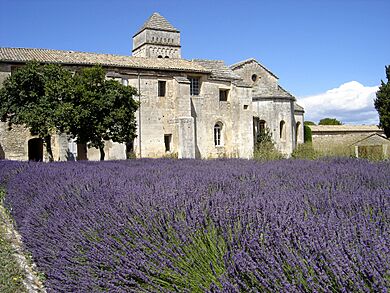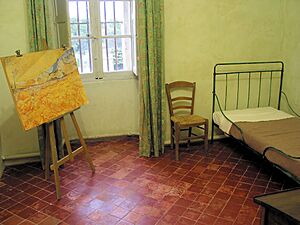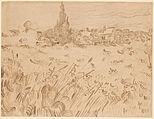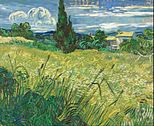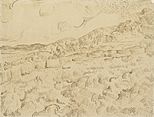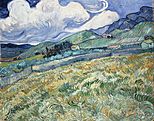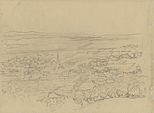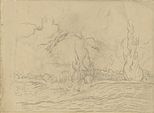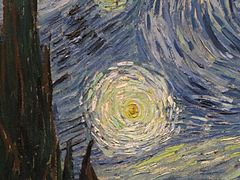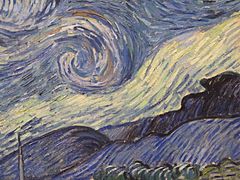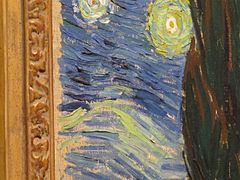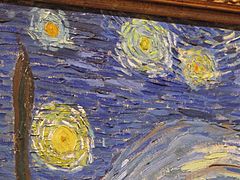The Starry Night facts for kids
Quick facts for kids The Starry Night |
|
|---|---|
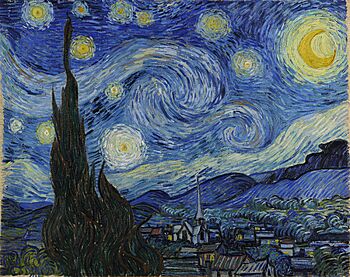 |
|
| Artist | Vincent van Gogh |
| Year | 1889 |
| Catalogue |
|
| Medium | Oil on canvas |
| Dimensions | 73.7 cm × 92.1 cm (29.01 in × 36.26 in) |
| Location | Museum of Modern Art, New York |
| Accession | 472.1941 |
The Starry Night (Dutch: De sterrennacht) is an oil-on-canvas painting by the Dutch Post-Impressionist painter Vincent van Gogh painted in June 1889. It depicts the view from the east-facing window of his asylum room at Saint-Rémy-de-Provence, just before sunrise, with the addition of an imaginary village. It has been in the permanent collection of the Museum of Modern Art in New York City since 1941, acquired through the Lillie P. Bliss Bequest. Widely regarded as Van Gogh's magnum opus, The Starry Night is one of the most recognizable paintings in Western art.
The asylum
In the aftermath of the 23 December 1888 breakdown that resulted in the cutting off his left ear, Van Gogh voluntarily admitted himself to the Saint-Paul-de-Mausole lunatic asylum on 8 May 1889. Housed in a former monastery, Saint-Paul-de-Mausole catered to the wealthy and was less than half full when Van Gogh arrived, allowing him to occupy not only a second-story bedroom but also a ground-floor room for use as a painting studio.
During the year Van Gogh stayed at the asylum in Saint-Rémy-de-Provence, the prolific output of paintings he had begun in Arles continued. During this period, he produced some of the best-known works of his career, including the Irises from May 1889, now in the J. Paul Getty Museum, and the blue self-portrait from September 1889, in the Musée d'Orsay. The Starry Night was painted mid-June by around 18 June, the date he wrote to his brother Theo to say he had a new study of a starry sky.
The painting
Although The Starry Night was painted during the day in Van Gogh's ground-floor studio, it would be inaccurate to state that the picture was painted from memory. The view has been identified as the one from his bedroom window, facing east, a view which Van Gogh painted variations of no fewer than twenty-one times, including The Starry Night. "Through the iron-barred window", he wrote to his brother, Theo, around 23 May 1889, "I can see an enclosed square of wheat ... above which, in the morning, I watch the sun rise in all its glory."
One of the first paintings of the view was F611 Mountainous Landscape Behind Saint-Rémy, now in Copenhagen. Van Gogh made several sketches for the painting, of which F1547 The Enclosed Wheatfield After a Storm is typical. It is unclear whether the painting was made in his studio or outside. In his 9 June letter describing it, he mentions he had been working outside for a few days. Van Gogh described the second of the two landscapes he mentions he was working on, in a letter to his sister Wil on 16 June 1889. This is F719 Green Wheat Field with Cypress, now in Prague, and the first painting at the asylum he painted en plein air. F1548 Wheatfield, Saint-Rémy de Provence, now in New York, is a study for it. Two days later, Vincent wrote to Theo stating that he had painted "a starry sky".
The Starry Night is the only nocturne in the series of views from his bedroom window. In early June, Vincent wrote to Theo, "This morning I saw the countryside from my window a long time before sunrise with nothing but the morning star, which looked very big". Researchers have determined that Venus (sometimes referred to as the "morning star") was indeed visible at dawn in Provence in the spring of 1889, and was at that time nearly as bright as possible. So the brightest "star" in the painting, just to the viewer's right of the cypress tree, is Venus.
The Moon is stylized, as astronomical records indicate that it was waning gibbous at the time Van Gogh painted the picture, and even if the phase of the Moon had been its waning crescent at the time, Van Gogh's Moon would not have been astronomically correct. (For other interpretations of the Moon, see below.) The one pictorial element that was not visible from Van Gogh's cell is the village, which is based on a sketch (F1541v) made from a hillside above the village of Saint-Rémy. Pickvance thought F1541v was done later, and the steeple more Dutch than Provençal, a conflation of several Van Gogh had painted and drawn in his Nuenen period, and thus the first of his "reminisces of the North" he was to paint and draw early the following year. Hulsker thought a landscape on the reverse (F1541r) was also a study for the painting.
-
F1548 Wheatfield, Saint-Rémy de Provence, Morgan Library & Museum
Provenance
After having initially held it back, Van Gogh sent The Starry Night to Theo in Paris on 28 September 1889, along with nine or ten other paintings. Theo died less than six months after Vincent, in January 1891. Theo's widow Jo became the caretaker of Van Gogh's legacy. In Paris in 1900 she sold the painting to a poet Julien Leclercq. In 1901 Leclercq sold it to Gauguin's old friend Émile Schuffenecker. Jo bought the painting back from Schuffenecker and in 1906 sold it to the Oldenzeel Gallery in Rotterdam. From 1906 to 1938 it was owned by Georgette P. van Stolk, of Rotterdam, who sold it to Paul Rosenberg, of Paris and New York. It was through Rosenberg that the Museum of Modern Art acquired the painting in 1941.
Painting materials
The painting was investigated by scientists at the Rochester Institute of Technology and the Museum of Modern Art in New York. The pigment analysis has shown that the sky was painted with ultramarine and cobalt blue, and for the stars and the moon, Van Gogh employed the rare pigment indian yellow together with zinc yellow.
- Details of Van Gogh's ''The Starry Night'' exhibited at the Museum of Modern Art of New York.
See also
 In Spanish: La noche estrellada para niños
In Spanish: La noche estrellada para niños
- List of works by Vincent van Gogh
- Baldin Collection
- "Vincent", 1971 song by Don McLean written as a tribute to Vincent van Gogh
- Timbres, espace, mouvement: an orchestral work (1978) by Henri Dutilleux inspired by the painting


